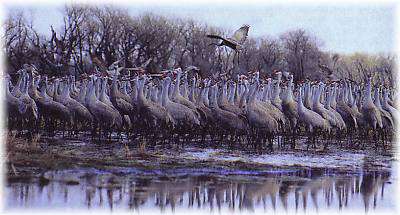Sandhill Crane Migration
category : Recreation

Fossil records reveal the sandhill cranes have been visiting this region for more than nine million years. For five weeks each spring, visitors to the Platte River valley in south-central Nebraska can enjoy the symphony of sounds and dancing rituals of 90 percent of the world's sandhill cranes. Approximately 500,000 sandhill cranes stop to gain energy from the fertile lands along the Platte River. From mid-February to mid-April the cranes can be seen and heard for 30 miles along the Platte River.
Cranes are in Nebraska for just one reason, to eat heartily and store energy for their migration. The cranes leave the river by the thousands in search of food at dawn. At this time, approximately 90 percent of their diet is corn, which quickly adds fat and puts them in ideal condition for the rest of their migration. The other 10 percent of their diet includes insects, earthworms, snails, and plants which together provide essential proteins for migration and egg production.
The shallow waters of the Platte offer perfect roosting areas, with sandbars at or just below the surface. These waters offer cranes the protection they need from predators through the night. Cranes will stay near the Platte River for about three weeks, until they have taken on the weight and nutrients they need for the rest of their migration.
Sandhill cranes will eventually leave the Platte valley in late March or April and follow the edge of winter north to their breeding grounds, ranging from the Canada border to the arctic and even into Siberia. It is at these breeding grounds the cranes will have 1-2 young and then, when the cold winds blow from the North, they will hitch a ride and begin their long journey south.
In addition to cranes, visitors will see 10 million ducks and geese that use the Platte and the neighboring Rainwater Basin wetlands. More than 2 million snow geese stopped in south-central Nebraska last spring alone.
The National Audubon Society's Rowe Sanctuary and Crane Meadows Nature Center also offer tours throughout the season to give visitors a closer look at cranes and waterfowl. Other viewing opportunities include driving the Auto Tour route of the Rainwater Basin and gravel roads to view feeding cranes. To experience the gathering of thousands of cranes in one spot, try the public viewing areas like the Fort Kearney Hike-Bike Trail or the NRD viewing platform at the Gibbon and Alda exits.
Public Viewing Decks
Enjoying the sunrise and sunset spectacles of cranes on the Plattte River is limited because most of the river edge is private property. Many people watch from road bridges that cross the Platte, creating a safety concern for viewers and those who use the roads and bridges during the crane season.
A task force led by the Central Platte Natural Resources District (CPNRD) is providing a series of free crane viewing decks for use by visitors. Parking is available at each viewing deck.
- Two locations on the river are the Richard Plautz Crane Viewing Site, 1 1/2 miles south of I-80 exit No. 285 (Gibbon), and the Alda Crane Viewing Site, 2 miles south of exit No. 305 (Alda).
- Three other roadside turnouts (south and east of the Alda interchange in Platte River Drive and west of the Rowe Sanctuary office on Elm Island Rd.) are in place for safe daytime viewing of cranes.
Come visit us in Nebraska, Nebraska